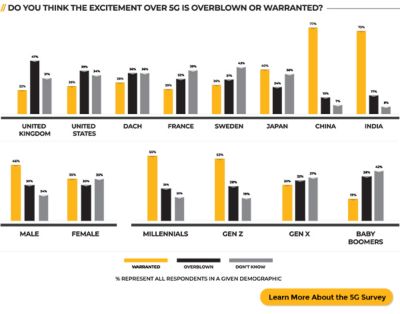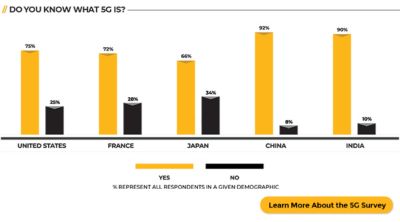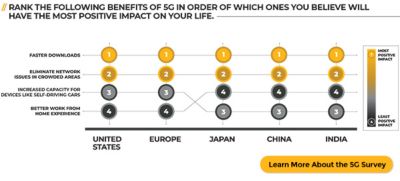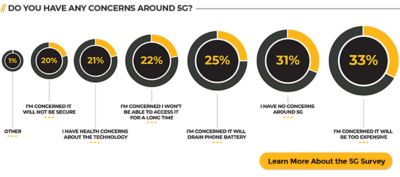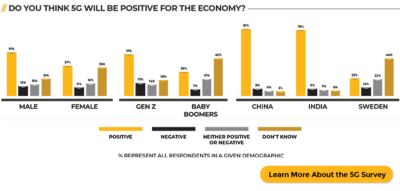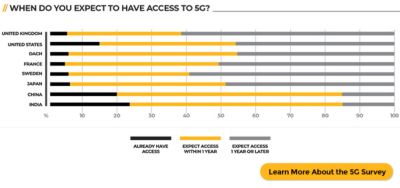-
United States -
United Kingdom -
India -
France -
Deutschland -
Italia -
日本 -
대한민국 -
中国 -
台灣
-
Ansys s'engage à préparer les étudiants d'aujourd'hui à la réussite, en leur fournissant gratuitement un logiciel de simulation.
-
Ansys s'engage à préparer les étudiants d'aujourd'hui à la réussite, en leur fournissant gratuitement un logiciel de simulation.
-
Ansys s'engage à préparer les étudiants d'aujourd'hui à la réussite, en leur fournissant gratuitement un logiciel de simulation.
-
Contactez-nous -
Carrières -
Étudiants et universitaires -
-
S'inscrire -
Déconnexion -
Espace client -
Support -
Communautés partenaires -
Contacter le service commercial
Pour les États-Unis et le Canada
+1 844.462.6797
-
Ansys Blog
June 23, 2020
5G Benefits That Will Change the World
Is all the hype around 5G warranted? Yes, according to a newly released survey commissioned by Ansys. It found that 41% of respondents — by far the majority response — confirmed that they believe the positivity around the technology is justified.
Respondents note if they think the excitement over 5G is overblown or warranted.
However, the same survey also revealed that public perception of 5G technology is clouded by confusion. Over one-fifth of respondents are unaware of what 5G actually is.
Over one-fifth of respondents are unaware what 5G is.
Similar uncertainty surrounded the transition from 3G to 4G. At that time, the general public and many experts could not have possibly predicted the impact it would have on our lives — from mobile HD video streaming to GPS-based ride-sharing and numerous work-from-anywhere cloud technologies.
So, let’s cut through the many mixed messages around 5G, bring some clarity and look ahead to some game-changing innovations in our future.
What Does 5G Mean Anyway?
5G stands for the fifth generation of cellular communication. It’s expected to be available across most of the U.S. by the end of 2020.
5G's maximum speed, depending on the network, is around 1 to 10 Gbps. For comparison, depending on the network, 4G LTE-A maxes out at 300 Mbps to 1 Gbps. Typically that translates to more than a 10X speedup.
Respondents rank 5G benefits
According to the survey, it is this speedup that most resonates with respondents. People can imagine this new technology bringing faster download speeds and the elimination of network issues in crowded areas.
So, what makes this new technology so much faster than its predecessor? It’s all about how the information travels.
The new network will use millimeter-wave and multiple-input, multiple-output (MIMO) technology that sends directional signals with lower latency, higher channel capacity and larger data rates.
The trade-off for these three benefits is that antenna infrastructure needs to be a few hundred feet apart. In comparison, current cellphone towers support an area of a few dozen miles. To learn more about this, and other 5G challenges, read: Understanding 5G Infrastructure Benefits & Challenges.
5G offers much more than the ability to download a movie 10-times faster than before. So, let’s take a look at what else it is likely to unleash.
5G Benefits to the Transportation Industry
4G certainly disrupted the taxi industry with the introduction of ridesharing. 5G is expected to disrupt the whole transportation industry by enabling fully autonomous vehicles.
Think of it, an autonomous car will contain sensors, cameras, sonar, lidar and radar systems that are expected to generate gigabytes of data a day. 4G can’t handle a whole fleet of vehicles transmitting this amount of data to surrounding technology, cloud-based computational resources and artificial intelligence (AI) systems.
But with 5G, transmitting this data and receiving instructions from disparate systems is much faster and more reliable. As a result, 5G infrastructure will be the catalyst for the widespread deployment of autonomous cars.
Even with the rollout of 5G, autonomous vehicles are still on the horizon. So, what benefits can we look forward to in the near future? Expect to see improved infotainment systems, advanced driver-assistance systems (ADAS) and semi-autonomous vehicles.
5G Benefits Will Democratize Healthcare
5G technology can also help to make healthcare systems more accessible.
For example, a significant number of patients need to spend large sums of money to travel the world in an effort to meet specialists that can operate on them. Though robotic virtual surgeries aren’t new, 5G could make these safer and more reliable.
Despite the concerns of respondents, 5G could save lives.
Doctors in China used a 5G-enabled remote surgery system to treat a patient who was 1,900 miles away. The latency between the surgical device and the doctors’ inputs was only two milliseconds. This means the doctors could react almost as fast as if they were in the room with the patient.
Similarly, medical technologies will be able to monitor patients in real time with the use of 5G and internet of medical things (IoMT) technology. As soon as a medical device detects an issue, such as an extreme low blood sugar, cardiac arrest or loss of blood pressure, it can notify the closest practitioners and first responders so they can act accordingly.
Industrial Applications of 5G Networks
5G networks will have a significant impact on industrial organizations with enablement of the industrial internet of things (IIoT), digital twins and massive machine-to-machine communication traffic.
Respondents note if they think 5G will be positive for the economy.
As traditional manufacturing machines become “smart” through the addition of sensors, 5G will provide the backbone that enables data communication between these machines and remote analytic systems.
This ensures that a digital twin of a physical asset can become a reality. The digital twin will enable operators to optimize performance, schedule maintenance and feed insights for the next generation of product improvements. This all results in higher performance, reduced downtime and faster product introductions, as well as new revenue streams based on the gathered data.
In the energy sector, distributed energy generation systems (such as solar panels and wind turbines) continue to rise at the expense of large, centralized facilities. This makes it more challenging to balance the power supply to match demand across a grid. With the high levels of rapid and reliable connectivity offered by 5G, this energy grid balancing act becomes more manageable.
Financial institutions, markets and traders will be equally affected by the new system. For instance, as soon as information starts trending on social media, news outlets or other information sources, 5G systems can send information to financial advisors, stock owners and trading systems.
Though 4G equivalents of this technology already exist, speed, bandwidth and latency of 5G can mean the difference of millions of dollars in the stock market. The new network will ensure traders and investors can respond instantaneously to global economic news.
To learn what industry leaders think of 5G, simulation and other advanced technologies, watch the Simulation World Keynote “A View from the CTOs Office: Simulation-based Product Innovation in the Digital World”:
The Future of 5G Is Bright
Though all of the benefits from the 5G enabled technologies mentioned here could displace and reshape many industries and social norms, as innovations go, they are low hanging fruit.
5G technology is coming. So, innovators need to start quick
if they are to be first to market.
The truth is that the low latency, high speeds and high capacity available on the new network will open up an unimaginable number of new technologies. A futurist would need a crystal ball to be able to predict them all.
So, perhaps it is these unknown possibilities that are the most exciting of all? The sky’s the limit, once the right technical experts and entrepreneurs are added to the mix.
Learn more about how consumers view 5G technology by reading the survey results from the Atomik Research commissioned by Ansys.











